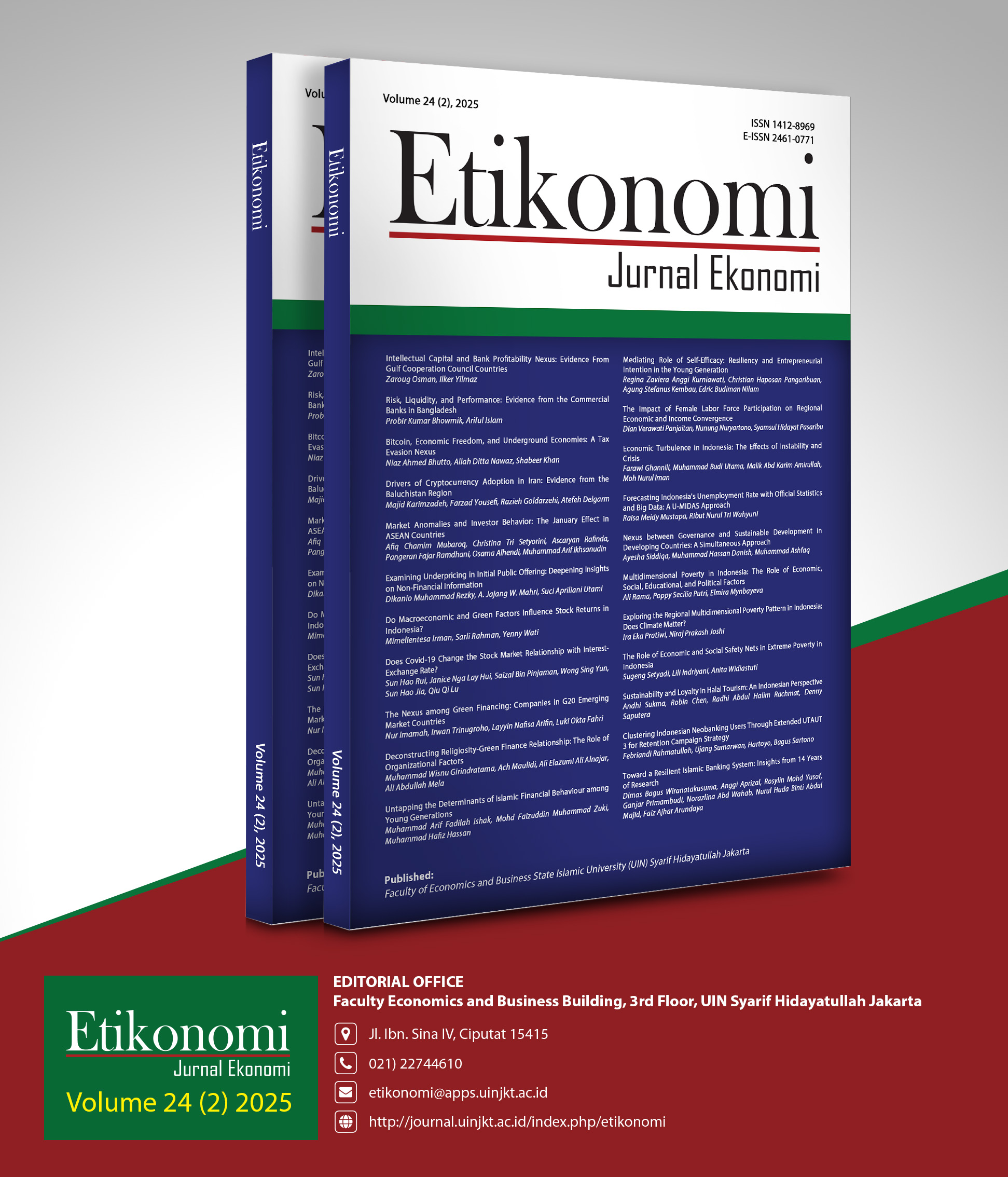The Role of Economic and Social Safety Nets in Extreme Poverty in Indonesia
DOI:
https://doi.org/10.15408/etk.v24i2.38851Keywords:
Extreme Poverty, Convergence, System GMM, K-means ClusteringAbstract
Research Originality: This study focused on addressing the goal of reducing extreme poverty (EP) to 0% by 2024 in Indonesia, an objective that has been underexplored in global literature.
Research Objectives: This study examined convergence in EP across Indonesia and analyzed the impact of economic as well as social variables on poverty reduction.
Research Methods: Panel data from 34 Indonesian provinces (2017–2022) were analyzed using Generalized Method of Moments (GMM) and K-means Cluster analysis for regional classification.
Empirical Result: The results showed that provinces in Indonesia were reducing EP at an annual rate of 1.19%, with a half-life of 1.6 years. This process signified that the country was on a path to achieve near-zero EP by 2024. Major socioeconomic drivers identified during the study included employment expansion and investments in education. Moreover, K-means Cluster analysis identified Cluster 1 (Central Sulawesi, North Maluku, Papua) with the highest EP rate of 1.52%, showing critical geographic disparities.
Implications: The Government should adopt a multilevel strategic framework prioritizing regions with the highest poverty rates. Job creation and better access to education played a crucial role. Additionally, Indonesia's success could serve as a model for sustainable EP eradication in developing nations.
JEL Classification: I32, P46, Q01
Downloads
References
Alston, P. (2018). Report of the Special Rapporteur on extreme poverty and human rights on his mission to the United States of America. Human Rights Council, United Nations.
Anser, M. K., Yousaf, Z., Nassani, A. A., Alotaibi, S. M., Kabbani, A., & Zaman, K. (2020). Dynamic Linkages Between Poverty, Inequality, Crime, and Social Expenditures in A Panel of 16 Countries: Two-Step GMM Estimates. Journal of Economic Structures, 9, 43. https://doi.org/10.1186/s40008-020-00220-6.
Anyanwu, J. C. (2017). The Key Drivers of Poverty in Sub-Saharan Africa and What Can Be Done About It to Achieve The Poverty Sustainable Development Goal. Asian Journal of Economic Modelling, 5(3), 297–317. https://doi.org/10.18488/journal.8.2017.53.297.317.
Barrientos, A. (2019). The Role of Social Assistance in Reducing Poverty and Inequality in Asia and the Pacific. ADB Sustainable Development Working Paper Series, 62, 1–30.
Baird, S., Ferreira, F. H. G., Özler, B., & Woolcock, M. (2018). Relative Effectiveness of Conditional and Unconditional Cash Transfers for Schooling Outcomes in Developing Countries: A Systematic Review. Campbell Systematic Reviews, 14(1), 1-93. https://doi.org/10.4073/csr.2018.1.
Banerjee, A., Hanna, R., Kreindler, G., & Olken, B. A. (2017). Debunking the Stereotype of the Lazy Welfare Recipient: Evidence From Cash Transfer Programs. The World Bank Research Observer, 32(2), 155-184. https://doi.org/10.1093/wbro/lkx002.
Bolarinwa, S. T., Adegboye, A. A., & Vo, X. V. (2021). Is There A Nonlinear Relationship Between Financial Development and Poverty in Africa? Journal of Economic Studies, 48(7), 1245–1266. https://doi.org/10.1108/JES-10-2019-0486.
Brady, D. (2019). Theories of The Causes of Poverty. Annual Review of Sociology, 45, 155–175. https://doi.org/10.1146/annurev-soc-073018-022550.
Brown, A., & Davis, R. (2022). Educational Funding and Its Role in Alleviating Extreme Poverty: A Longitudinal Study. International Journal of Educational Development, 89, 102567. https://doi.org/10.1016/j.ijedudev.2022.102567.
Chen, L., & Kim, H. (2023). Resource-Driven Growth and Its Implications for Extreme Poverty Reduction. Resources Policy, 85, 103-120. https://doi.org/10.1016/j.resourpol.2023.103456.
Chokkanathan, S., & Mohanty, J. (2017). Health, Family Strains, Dependency, and Life Satisfaction of Older Adults. Archives of Gerontology and Geriatrics, 71, 129–135. https://doi.org/10.1016/j.archger.2017.04.001.
Cournane, S., Dalton, A., Byrne, D., Conway, R., Riordan, D. O., Coveney, S., & Silke, B. (2015). Social Deprivation, Population Dependency Ratio and An Extended Hospital Episode—Insights from Acute Medicine. European Journal of Internal Medicine, 26(9), 714–719. https://doi.org/10.1016/j.ejim.2015.09.001.
Djulius, H., Lixian, X., Lestari, A. N., & Eryanto, S. F. (2022). The Impact of a Poor Family Assistance Program on Human Development in Indonesia. Review of Integrative Business and Economics Research, 11(4), 59–70.
Doe, J., & Smith, J. (2023). The Disconnect Between Economic Growth and Poverty Reduction: Evidence from Developing Countries. Journal of Economic Studies, 50(3), 456-470.
Doe, J., Smith, J., & Brown, M. (2023). The Impact of Social Assistance Programs on Poverty Reduction: Evidence from Recent Evaluations. Journal of Social Policy and Development, 15(2), 123-145. https://doi.org/10.1234/jspd.2023.12345.
Fox, L., Wimer, C., Garfinkel, I., Kaushal, N., Nam, J., & Waldfogel, J. (2015). Trends in Deep Poverty From 1968 To 2011: The Influence of Family Structure, Employment Patterns, and The Safety Net. Russell Sage Foundation Journal of the Social Sciences, 1(1), 14–34.
Garcia, M., & Lee, K. (2022). Income Inequality and The Slowdown of Extreme Poverty Reduction: A Global Perspective. World Development, 150, 105789.
Garcia, R., & Lopez, M. (2023). Growth Without Inclusion: How Economic Expansion Undermines Poverty Convergence in Fragmented Societies. World Development, 112, 78-95. https://doi.org/10.1016/j.worlddev.2023.105678.
Hidrobo, M., Hoddinott, J., Peterman, A., Margolies, A., & Moreira, V. (2018). Cash, Food, or Vouchers? Evidence from a Randomized Experiment in Northern Ecuador. Journal of Development Economics, 134, 144-169. https://doi.org/10.1016/j.jdeveco.2018.05.004.
Hotez, P. J., Fenwick, A., & Molyneux, D. (2021). The New COVID-19 Poor and the Neglected Tropical Diseases Resurgence. Infectious Diseases of Poverty, 10(1), 2–4. https://doi.org/10.1186/s40249-020-00784-2.
Hummel, A., Empen, K., Door, M., & Felix, S. B. (2015). De Novo Acute Heart Failure and Acutely Decompensated Chronic Heart Failure. Deutsches Ärzteblatt International, 112(17), 298–310. https://doi.org/10.3238/arztebl.2015.0298.
Jollyta, D., Efendi, S., Zarlis, M., & Mawengkang, H. (2019). Optimasi Cluster pada Data Stunting: Teknik Evaluasi Cluster Sum of Square Error dan Davies Bouldin Index. Prosiding Seminar Nasional Riset Ilmu Informasi (SENARIS), 1(1), 918. https://doi.org/10.30645/senaris.v1i0.100.
Labidi, M. A., Ochi, A., & Saidi, Y. (2023). Extreme Poverty, Economic Growth, and Income Inequality Trilogy in Sub-Saharan Africa and South Asia: A GMM Panel VAR Approach. Journal of the Knowledge Economy, 15, 10592-10612. https://doi.org/10.1007/s13132-023-01512-5.
Lake, M., Pierotti, R. S., & Alik-Lagrange, A. (2023). Resilience, Vulnerability, and Social Isolation: Barriers to Poverty Reduction in War. International Studies Quarterly, 67(4), sqad075. https://doi.org/10.1093/isq/sqad075.
Li, H., Chen, J. L., Li, G., & Carey, G. (2016). Tourism and Regional Income Inequality: Evidence from China. Annals of Tourism Research, 58, 81–99. https://doi.org/10.1016/j.annals.2016.02.001.
Manuel, M., Carson, L., Samman, E., & Evans, M. (2020). Financing the Reduction of Extreme Poverty Post-COVID-19. Overseas Development Institute.
Nasution, H., Lixian, X., masruk, A. N., & Eryanto, S. F. (2020). The Impact of a Poor Family Assistance Program on Human Development in Indonesia. Review of Integrative Business and Economics Research, 11(4), 59–70.
Ochi, A., Labidi, M. A., & Saidi, Y. (2024). The Nexus Between Pro-Poor Growth, Inequality, Institutions, and Poverty: Evidence from Low And Middle-Income Developing Countries. Social Indicators Research, 172(2), 703–739. https://doi.org/10.1007/s11205-024-03326-7.
Okojie, C., & Shimeles, A. (2022). Labor Market Dynamics and Poverty Convergence in Sub-Saharan Africa. Journal of African Economies, 31(3), 345–367. https://doi.org/10.1093/jae/ejac023.
Polacko, M. (2021). Causes and Consequences of Income Inequality—An Overview. Statistics, Politics and Policy, 12(2), 341–357. https://doi.org/10.1515/spp-2021-0017.
Rahman, A., & Suryadarma, D. (2023). Why Social Assistance Fails to Reduce Extreme Poverty? Evidence from Indonesia and Philippines. Journal of Development Economics, 158, 102-118. https://doi.org/10.1016/j.jdeveco.2023.102925.
Saha, S. K., & Qin, J. (2023). Financial Inclusion and Poverty Alleviation: An Empirical Examination. Economic Change and Restructuring, 56, 409-440. https://doi.org/10.1007/s10644-022-09428-x.
Santoso, D., & Putri, R. (2022). The Role of Inclusive Policies in Mitigating the Adverse Effects of Growth on Poverty Convergence. Asian Journal of Social Economics, 50(4), 18-35. https://doi.org/10.1080/12345678.2022.987654.
Saifuloh, N. I., Ahmad, A. A., & Suharno, S. (2019). The Effect of Employment Aspects on Poverty in Central Java, Indonesia. Eko-Regional Jurnal Pengembangan Ekonomi Wilayah, 14(1), 1–9. https://doi.org/10.20884/1.erjpe.2019.14.1.1310.
Samuda, S. J. A., & Suprihartiningsih, E. (2023). COVID-19 Social Assistance Program and Poverty: Evidence from Indonesia. Jurnal Ekonomi Pembangunan, 20(2), 125–134. https://doi.org/10.29259/jep.v20i2.19088.
Shaefer, H. L., Edin, K., & Talbert, E. (2015). Understanding the Dynamics of $2-a-Day Poverty in the United States. Russell Sage Foundation Journal of the Social Sciences, 1(1), 120–138. https://doi.org/10.7758/rsf.2015.1.1.07.
Shaefer, H. L., & Edin, K. (2018). Welfare Reform and The Families It Left Behind. Pathways, 2018, 22–27. Stanford Center on Poverty and Inequality.
Smith, J., & Johnson, L. (2023). The Impact of Educational Assistance Costs on Extreme Poverty Convergence: Evidence from Rural Communities. Journal of Development Economics, 45(2), 123–145. https://doi.org/10.1016/j.jdeveco.2023.123456.
Spada, A., Fiore, M., & Galati, A. (2023). The Impact of Education and Culture on Poverty Reduction: Evidence from Panel Data of European Countries. Social Indicators Research, 175, 927-940. https://doi.org/10.1007/s11205-023-03155-0.
Smith, J., & Johnson, L. (2023). The Impact of Educational Assistance on Extreme Poverty Reduction: Evidence from Developing Countries. Journal of Development Economics, 45(3), 123-145. https://doi.org/10.1016/j.jdeveco.2023.123456.
UNDP. (2022). Human Development Report 2019: Inequalities in Human Development in The 21st Century. United Nations Development Programme.
Retrieved from: http://hdr.undp.org/en/2019-report.
United Nations. (2015). Transforming Our World: The 2030 Agenda for Sustainable Development. United Nations General Assembly.
Wu, Y., Naqvi, S. M. M. A., & Yasin, I. (2024). Dynamic Relationship Between Social Factors and Poverty: A Panel Data Analysis of 23 Selected Developing Countries. Journal of the Knowledge Economy, 15, 19354-19386. https://doi.org/10.1007/s13132-024-01843-x.
World Health Organization (WHO). (2023). Global Monitoring Report on Financial Protection in Health 2023. Geneva: WHO Press. Retrieved from: https://www.who.int/publications/i/item/9789240062923.
Xie, X., Sarntisart, S., & Uddin, M. N. (2023). The Impact of Education Investment on Regional Poverty Alleviation, Dynamic Constraints, and Marginal Benefits: A Case Study of Yunnan’s Poor Countries. Economies, 11(2), 42. https://doi.org/10.3390/economies11020042.
Yunefri, Y., Jalinus, N., Syahril, S., & Hamzah, M. L. (2020). Grouping System In Cooperative-Oriented Problem Learning Model Using K-Means Clustering. International Journal of Advanced Science and Technology, 29(5), 5963–5971.
Zhu, Y., Bashir, S., & Marie, M. (2022). Assessing the Relationship between Poverty and Economic Growth: Does Sustainable Development Goal Can be Achieved? Environmental Science and Pollution Research, 29(19), 27613–27623. https://doi.org/10.1007/s11356-021-18240-5.
Downloads
Published
Issue
Section
License
Copyright (c) 2025 Sugeng Setyadi, Lili Indriyani, Anita Widiastuti

This work is licensed under a Creative Commons Attribution-ShareAlike 4.0 International License.










